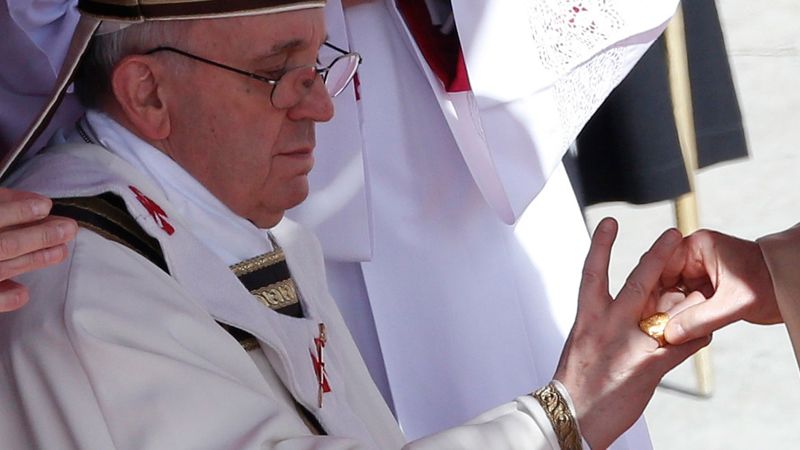Pope Francis' Ring: Destruction After Death – A Symbol of Humility
Editor’s Note: News has broken today regarding the Pope's decision to have his papal ring destroyed after his death. This article delves into the significance of this choice and its implications.
Why This Topic Matters
The destruction of Pope Francis's ring after his death is far more than a simple act; it's a powerful statement about humility, legacy, and the rejection of materialism within the Catholic Church. This decision resonates deeply with the Pope's consistent message of simplicity and service to the poor, reflecting a shift in papal tradition and sparking considerable discussion about the symbolism of power and authority within religious leadership. This article will examine the historical context of papal rings, the significance of Francis's decision, and its potential impact on future papal practices.
Key Takeaways
| Point | Description |
|---|---|
| Tradition Broken | Pope Francis departs from the centuries-long tradition of preserving papal rings. |
| Symbolic Humility | The act signifies a rejection of worldly power and a focus on spiritual legacy. |
| Modern Approach | Reflects Pope Francis's progressive approach to Catholicism and its public image. |
| Impact on Future Popes | May influence future popes to consider similar actions, promoting simplicity. |
| Public Perception | Generates discussion on the role of symbols and material possessions in religious leadership. |
Pope Francis' Ring: A Symbol of Humble Legacy
The decision by Pope Francis to have his Fisherman's Ring destroyed upon his death marks a significant departure from centuries of papal tradition. This ring, a symbol of the papal office since the Middle Ages, has historically been preserved as a relic, often displayed in museums or kept within the Vatican archives. Francis's choice to break with this tradition underscores his consistent emphasis on humility and service, mirroring his rejection of opulent lifestyles and his focus on the plight of the marginalized.
Key Aspects of the Decision
- Rejection of Materialism: The act directly counters the association of papal power with material wealth and earthly possessions.
- Focus on Spiritual Legacy: By directing the destruction of the ring, Francis emphasizes the importance of his spiritual legacy over material symbols of authority.
- Emphasis on Simplicity: This decision aligns with his broader message of simple living and devotion to faith, not worldly goods.
Detailed Analysis
The destruction of the ring serves as a powerful counterpoint to the historical accumulation of papal treasures and artifacts. Historically, papal rings were seen as tangible representations of power and continuity, passed down through generations. Francis's action challenges this perception, suggesting that true authority lies not in material objects but in spiritual leadership and dedication to the faith. This proactive rejection of tradition is a bold statement, likely to resonate with those who admire his commitment to social justice and his call for a more humble church.
The Significance of the Fisherman's Ring
The Fisherman's Ring, with its depiction of St. Peter fishing, is intrinsically linked to the papacy's authority and lineage. Its destruction, therefore, carries symbolic weight, suggesting a deliberate severing of the material ties to the past. This is a remarkable act, particularly given the historical reverence for such artifacts.
Facets of the Fisherman's Ring's Symbolism
- Roles: Traditionally, the ring signified the authority of the Pope as the successor to St. Peter.
- Examples: Previous papal rings have been meticulously preserved, showcasing the historical continuity of the papacy.
- Risks: The destruction of the ring could be interpreted as a rejection of tradition by some within the Catholic Church.
- Mitigations: The Pope’s clear communication of his reasoning helps mitigate potential negative interpretations.
- Impacts: The decision may inspire a reassessment of the importance of material symbols within religious leadership.
People Also Ask (NLP-Friendly Answers)
Q1: What is the Fisherman's Ring?
A: The Fisherman's Ring is a ring worn by the Pope, traditionally bearing an image of St. Peter fishing. It's a symbol of his authority and office.
Q2: Why is Pope Francis destroying his ring?
A: Pope Francis is destroying his ring as a symbol of humility, rejecting the association of papal power with material possessions and emphasizing his spiritual legacy.
Q3: How does this impact the Catholic Church?
A: This action could influence future popes to adopt simpler practices, sparking conversations about the Church's relationship with material wealth and power.
Q4: What are the potential criticisms of this decision?
A: Some may criticize the decision as a rejection of tradition and the loss of a historical artifact.
Q5: What's the significance of St. Peter's image on the ring?
A: St. Peter's image symbolizes the Pope's role as the successor to St. Peter and the leader of the Catholic Church.
Practical Tips for Understanding Pope Francis' Legacy
- Research Papal History: Understanding past papal practices helps contextualize Francis's decision.
- Read Papal Encyclicals: Familiarize yourself with Pope Francis's teachings on humility and social justice.
- Follow Catholic News: Stay updated on discussions surrounding this decision and its broader implications.
- Engage in respectful dialogue: Discuss the significance of this action with others, considering diverse perspectives.
- Reflect on personal values: Consider how this decision challenges personal views on materialism and spiritual leadership.
Summary (Resumen)
Pope Francis's decision to have his Fisherman's Ring destroyed after his death is a bold and symbolic act. It underscores his commitment to humility, challenging long-standing traditions and sparking important conversations about the role of material possessions within religious leadership.
Closing Message (Mensaje Final)
This decision offers a potent lesson on the ephemerality of worldly power and the enduring nature of spiritual impact. What lasting legacy will you leave behind?
Call to Action (Llamada a la Acción)
Share this article to spark discussion on the significance of Pope Francis’s decision. Subscribe to our newsletter for more insightful analyses on religious affairs!
(Hreflang tags would be inserted here depending on the target languages for the article)

